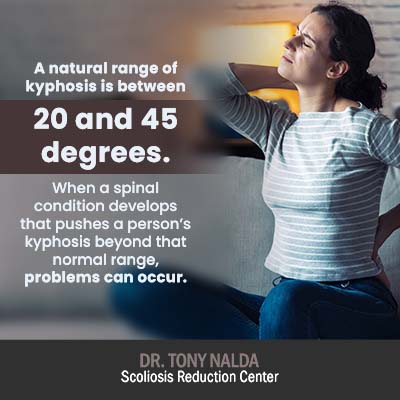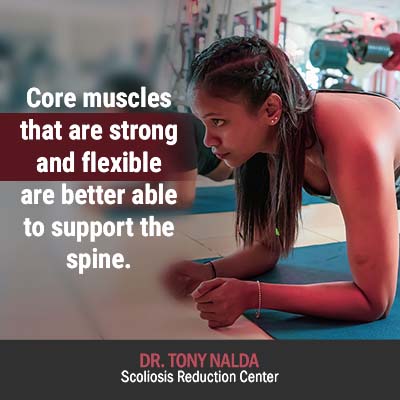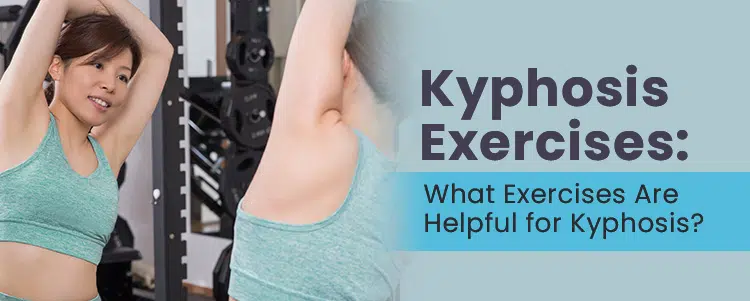The spine’s kyphotic curves are those that curve outwards, away from the body’s center, and while there is a normal range of healthy kyphosis, when a curvature falls beyond that healthy range, the biomechanics of the spine are affected. When combined with a proactive chiropractic-centered treatment plan, spinal-extensor exercises can help augment corrective results.
Also known as roundback, Kyphosis involves an exaggerated outward curve of the upper back that gives it a pitched-forward appearance. Through treatment that combines chiropractic care and spinal-extensor exercises, a normal range of kyphosis can be restored, along with the spine’s biomechanics.
Before we get into the specifics of kyphosis exercises, let’s first talk about the spine’s healthy curvatures and what happens when they are replaced by unhealthy curves.
A Healthy Spine
A healthy spine will look like an ‘S’ when viewed from the sides, and will appear straight when viewed from the front or back; this is because of the spine’s natural and healthy curvatures.
Lordosis refers to the spine’s curvatures that bend inwards, towards the body’s center, and the term kyphosis refers to spinal curvatures that bend outwards, away from the body’s center.
In a healthy spine, there is a normal degree-of-curvature range, but when a spinal condition develops that pushes that range beyond a normal level, the spine’s health and function are impacted.
A healthy spine is naturally curved because it gives it more strength, flexibility, and allows it to evenly absorb and distribute mechanical stress. When there is a loss of the spine’s natural and healthy curves, the spine becomes misaligned and disrupts its biomechanics.
There are three main sections of the spine: cervical (neck), thoracic (upper/middle back), and lumbar (lower back).
Lordotic curves are found in the cervical and lumbar spinal regions, while the thoracic region has a kyphotic curve.
The terms hyperlordosis and hyperkyphosis are often used interchangeably with lordosis and kyphosis, in reference to conditions where these curvature types are exaggerated.

A natural range of kyphosis is between 20 and 45 degrees. When a spinal condition develops that pushes a person’s kyphosis beyond that normal range, problems can occur.
Fortunately, there is treatment that can work towards achieving corrective results in the form of a curvature reduction that addresses the condition on a structural level, and increasing core strength so the spine is better supported and stabilized.
Here at the Scoliosis Reduction Center®, I combine different treatment disciplines for the most customized and effective treatment plans possible.
When combined with kyphosis-specific chiropractic care, spinal-extensor exercises can help achieve corrective results by restoring the spine’s biomechanics, strength, and flexibility.
What Exercises Are Good for Kyphosis?
Just as there are different types of spinal conditions a person can develop, there are different types of kyphosis, both postural and structural.
When a condition is postural, this means it’s caused by poor posture and body positioning, and this can be addressed through exercises and stretches that encourage healthy posture.
When a condition is structural, there is an abnormality within the spine itself that is causing the excessive rounding of the upper back, and this type is more complex to treat because it has to be, first and foremost, impacted on a structural level.
While there are never treatment guarantees, combining chiropractic care with spinal-extensor exercises has potential to adjust the most-tilted vertebrae (bones of the spine) back into alignment with the rest of the spine, and certain exercises can increase core strength so the extensor muscles that run alongside the spine can optimally support and stabilize it.
Spinal-extension exercises can make the back muscles stronger and better able to counteract the condition’s forward pull on the spine, meaning exercises that help strengthen spinal-extensor muscles can help reduce a patient’s angle of kyphosis.
Exercises that are known to promote core strengthening and spinal-extensor stretching and strengthening include head retraction, mirror image, life extension, Superman extensions, and thoracic spine foam rolling.
Head Retraction
The head retraction exercise targets the muscles of the neck that can become stretched and weak through excessive kyphosis that pushes the head forward and increases its weight on the muscles that support it.
This exercise is done by lying flat on the floor and pulling the chin back toward the floor. Holding this position for 15 seconds and repeating 5 to 10 times can help with pain relief and overly-tight neck muscles.
Neck muscles that are tight and overworked become weak and as their ability to support the spine and the weight of the head is compromised, a patient’s angle of kyphosis can increase.
Mirror Image
The mirror image exercise is simple but effective and involves moving in opposition to the posture that’s problematic.
This exercise involves standing tall (standing against a wall can help) and tucking in the chin slightly while pulling the head back so it’s centered over the shoulders.
This will feel as if the shoulder blades are being pulled back and down. Holding the position from 30 seconds to a minute can be effective as it places the upper back in a position that counteracts the forward pull on the spine and helps encourage better posture and body positioning.
Life Extension
When it comes to maintaining natural and healthy spinal curvatures, it’s not just the spine itself that’s tasked with this; it’s also the spine’s surrounding muscles that support and stabilize the spine.
The goal of the life extension exercise is to stretch overly tight muscles of the chest and strengthen weakened muscles of the back.
Life extension is performed by standing tall with the knees loose, the core engaged, chest held upright, and the shoulder blades held back and down.
When this ideal posture is reached, extending the arms above the head into a ‘Y’ position with thumbs pointed behind and holding it helps extend and stretch the chest muscles and strengthen the spinal-extensor muscles.
Superman Extension

Core muscles that are strong and flexible are better able to support the spine.
The Superman extension exercise involves lying flat on the stomach with arms outstretched in front of the head.
With the head in a neutral position facing the floor, the arms and legs are lifted toward the ceiling and out from the body at the same time.
Holding this position for 3 seconds and repeating 10 times can help keep the core muscles loose, flexible, and strong.
Thoracic Spine Foam Rolling
Thoracic spine foam rolling can help counteract the pitched-forward body positioning caused by kyphosis and provide relief for strained and tight muscles.
This exercise is done by lying flat on the floor with a foam roller underneath the middle back (thoracic spine) and gently rolling up and down the roller.
The motion will massage and stretch the muscles of the back and thoracic spine.
What Muscles are Weak in Kyphosis?
To answer the question, what muscles are weak in kyphosis, it’s generally the upper and middle back extensor muscles that are strained as excessive kyphosis pitches the upper back forward, causing the characteristic roundback appearance.
The muscles of the neck (cervical spine) are also weakened as the forward shift of the spine can cause related forward head posture, known to increase the weight of the head by 10 pounds with every inch that the head moves forward.
Conclusion
There are many spinal conditions a person can develop that involve a loss of the spine’s healthy and natural curvatures.
When this occurs, the spine’s overall biomechanics are disrupted, and this can cause varying levels of pain, postural changes, and functional deficits.
Kyphosis is a common spinal condition that involves an exaggerated kyphosis of the thoracic spine. Also known as roundback, the over-pronounced outward curvature of the thoracic spine can cause a pitched-forward appearance with a noticeable arch in the upper back.
Kyphosis is also related to forward head posture which involves the unnatural curvature of the upper back shifting the position of the head forward, and this increases its weight on the neck and upper back muscles, leading to stiff, tight, strained, and sore muscles.
While exercises and stretches on their own are limited in their corrective potential, when combined with kyphosis-specific chiropractic care and other forms of effective treatment such as therapy and corrective bracing, they can help augment treatment working towards curvature reductions on a structural level by improving muscle strength and flexibility.
Here at the Scoliosis Reduction Center®, I’ve successfully treated many cases of kyphosis by crafting highly-specific treatment plans that combine chiropractic care to achieve curvature reductions, corrective bracing when necessary, and spinal-extensor exercises to help increase core strength so the spine is optimally supported and stabilized.





